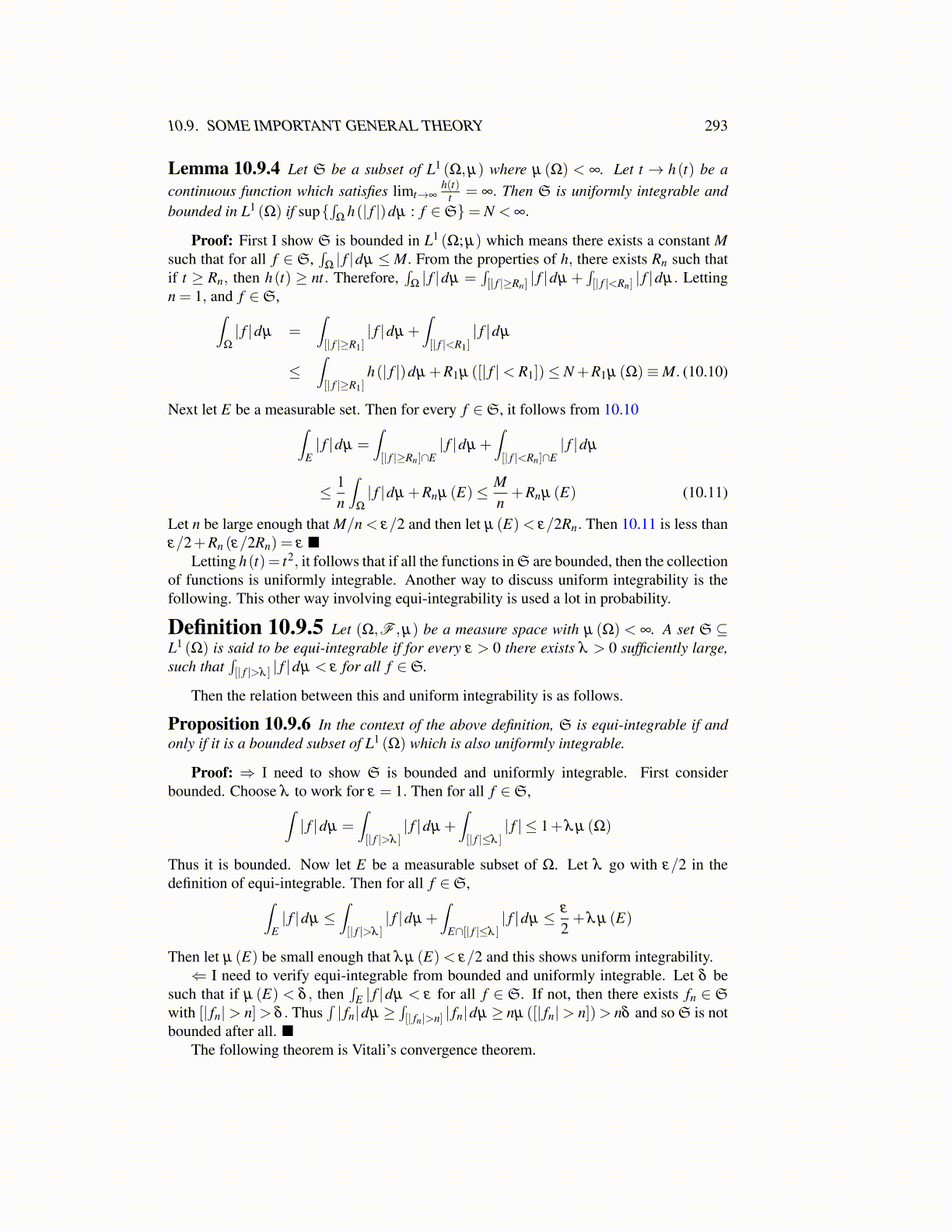
10.9. SOME IMPORTANT GENERAL THEORY 293
Lemma 10.9.4 Let S be a subset of L1 (Ω,µ) where µ (Ω) < ∞. Let t → h(t) be acontinuous function which satisfies limt→∞
h(t)t = ∞. Then S is uniformly integrable and
bounded in L1 (Ω) if sup{∫
Ωh(| f |)dµ : f ∈S}= N < ∞.
Proof: First I show S is bounded in L1 (Ω; µ) which means there exists a constant Msuch that for all f ∈S,
∫Ω| f |dµ ≤M. From the properties of h, there exists Rn such that
if t ≥ Rn, then h(t) ≥ nt. Therefore,∫
Ω| f |dµ =
∫[| f |≥Rn]
| f |dµ +∫[| f |<Rn]
| f |dµ. Lettingn = 1, and f ∈S,∫
Ω
| f |dµ =∫[| f |≥R1]
| f |dµ +∫[| f |<R1]
| f |dµ
≤∫[| f |≥R1]
h(| f |)dµ +R1µ ([| f |< R1])≤ N +R1µ (Ω)≡M. (10.10)
Next let E be a measurable set. Then for every f ∈S, it follows from 10.10∫E| f |dµ =
∫[| f |≥Rn]∩E
| f |dµ +∫[| f |<Rn]∩E
| f |dµ
≤ 1n
∫Ω
| f |dµ +Rnµ (E)≤ Mn+Rnµ (E) (10.11)
Let n be large enough that M/n < ε/2 and then let µ (E)< ε/2Rn. Then 10.11 is less thanε/2+Rn (ε/2Rn) = ε ■
Letting h(t)= t2, it follows that if all the functions in S are bounded, then the collectionof functions is uniformly integrable. Another way to discuss uniform integrability is thefollowing. This other way involving equi-integrability is used a lot in probability.
Definition 10.9.5 Let (Ω,F ,µ) be a measure space with µ (Ω) < ∞. A set S ⊆L1 (Ω) is said to be equi-integrable if for every ε > 0 there exists λ > 0 sufficiently large,such that
∫[| f |>λ ] | f |dµ < ε for all f ∈S.
Then the relation between this and uniform integrability is as follows.
Proposition 10.9.6 In the context of the above definition, S is equi-integrable if andonly if it is a bounded subset of L1 (Ω) which is also uniformly integrable.
Proof: ⇒ I need to show S is bounded and uniformly integrable. First considerbounded. Choose λ to work for ε = 1. Then for all f ∈S,∫
| f |dµ =∫[| f |>λ ]
| f |dµ +∫[| f |≤λ ]
| f | ≤ 1+λ µ (Ω)
Thus it is bounded. Now let E be a measurable subset of Ω. Let λ go with ε/2 in thedefinition of equi-integrable. Then for all f ∈S,∫
E| f |dµ ≤
∫[| f |>λ ]
| f |dµ +∫
E∩[| f |≤λ ]| f |dµ ≤ ε
2+λ µ (E)
Then let µ (E) be small enough that λ µ (E)< ε/2 and this shows uniform integrability.⇐ I need to verify equi-integrable from bounded and uniformly integrable. Let δ be
such that if µ (E) < δ , then∫
E | f |dµ < ε for all f ∈ S. If not, then there exists fn ∈ Swith [| fn|> n]> δ . Thus
∫| fn|dµ ≥
∫[| fn|>n] | fn|dµ ≥ nµ ([| fn|> n])> nδ and so S is not
bounded after all. ■The following theorem is Vitali’s convergence theorem.